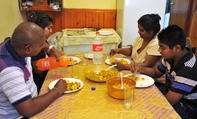Diverse Tastes Shaping Lifestyles
Food inflation impacts the access to food. But once a family has that food, other factors determine how they choose to use that food, which also has implications for whether or not they remain food secure. And this is where the deeply cultural nature of our relationship with food becomes so evident, shaping our choices about how we eat or how we relate to what others eat.

Our shifting preference for modern processed foods is certainly shaping the palate of urbanised populations, with fairly dramatic consequences for our health. But there are also lingering cultural tastes that determine why one family might choose mealie meal while another could go for pasta linguine.
One couple may choose to drink a chilled Chardonnay, another family's palate may be attuned to the taste of umqombothi (traditional African beer), while someone else might prefer Coca-Cola, and another water.
The range of food and drink styles are as diverse as the cultures and lifestyles of the people consuming them: Cape Malay curry, Thai noodles, umphokoqo (corn porridge) with meat stew, take-away burger and chips, roast beef and vegetables, cook-in-a-bag fish, braaied snoek (barbecued fish).
Health Implications
It is a diversity of taste that is wonderfully reflective of our different backgrounds, but it is also a reason why one culture cannot foist its culinary preferences on another. So any kind of food aid or support of nutritional education should not expect a family that has grown up on mild umngqusho (samp and beans) to adopt a spicy curry, or give pork to a Muslim family, or expect a staple maize eater to suddenly adopt sorghum as their new plate-filler, and you would not give eggs to a vegan.
Similarly, for someone who did not grow up eating fresh fruit and vegetables, it is difficult to learn to love them later in life. All this has implications for the way we choose to eat and, consequently, for our health.
The point is that when people try to educate communities on issues of nutrition, for instance, and want to bring about a change in behaviour to improve someone's well-being, they need to remember that culture is the bedrock upon which another's food choice is made.
Some communities, particularly in the shack-lands around our bristling concrete metropolises, live in food deserts where they are either too far from suppliers of wholesome food or it is too expensive to have these foods constitute the biggest part of their diet.
Driven by a cash-strapped budget, they lean towards the low-nutrient bulky foods over the more expensive fresh vegetables, which are a high-risk investment given how easily they perish and are damaged. This tendency of poor people to lean on cheap, high-energy, low-nutrient foods is driving an apparently contradictory situation where you increasingly find a malnourished individual living inside the skin of a fat or obese person.
By Leonie Joubert